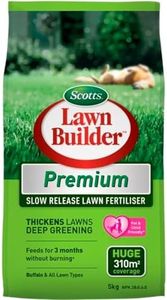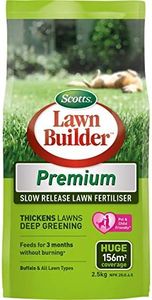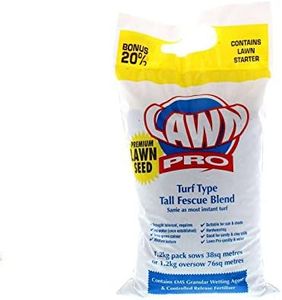We Use CookiesWe use cookies to enhance the security, performance,
functionality and for analytical and promotional activities. By continuing to browse this site you
are agreeing to our privacy policy
4 Best Grass Seed Starter Fertilizer
From leading brands and best sellers available on the web.Buying Guide for the Best Grass Seed Starter Fertilizer
Choosing the right grass seed starter fertilizer is essential if you want your lawn to establish itself healthy and lush from the very start. Starter fertilizers are specially designed to give your new grass seeds the nutrients they need to sprout, root, and grow vigorously in their first weeks. To find the best fit, you should consider the blend of nutrients, how quickly it releases those nutrients, and any additional soil needs your specific lawn might have.N-P-K RatioThe N-P-K ratio stands for the amount of Nitrogen (N), Phosphorus (P), and Potassium (K) in a fertilizer. This ratio is important because each nutrient has a specific role: nitrogen boosts leaf growth, phosphorus supports strong root development, and potassium helps overall plant health. Starter fertilizers generally have higher phosphorus since new grass needs to develop strong roots. Ratios like 10-20-10 or 12-24-12 are common. When picking, if your soil already has phosphorus or local laws limit its use, select a formula that matches those conditions. For most new lawns, a balanced starter with extra phosphorus is ideal, unless a soil test tells you otherwise.
Release Type (Quick vs. Slow Release)Fertilizers can release their nutrients either quickly or slowly. Quick-release formulas make nutrients available to plants right away, helping seeds sprout faster, while slow-release types provide nutrients over a longer time, reducing the need for frequent reapplication. For grass seed starter fertilizers, quick or combined quick/slow release is usually preferred to give that immediate boost for germination and early growth. If you want to minimize maintenance after seeding, a slow-release component can help. Choose based on whether you're able to monitor and reapply fertilizer, or if you want a more hands-off approach.
Granular vs. Liquid ApplicationStarter fertilizers come in both granular (pellet) and liquid forms. Granular fertilizers are easy to spread and are best for wide, even coverage, making them suitable for larger lawns or for those using broadcast spreaders. Liquid fertilizers work faster since they are absorbed quickly, but they may require specialized sprayers and more frequent application. If you want a straightforward, single-step process, go for granular. Use liquids if you want rapid effects and don't mind reapplying or if you're treating just a small area.
Soil CompatibilityThe type and condition of your soil can significantly impact how well your seeds grow. Some starter fertilizers are formulated specifically for certain soil types, such as sandy, clay, or loamy soils. They may also address pH imbalances or contain micronutrients like iron or magnesium. Before picking, consider getting a simple soil test to check your soil’s pH and nutrient levels. This lets you choose a starter fertilizer that addresses any deficiencies, ensuring your seeds get exactly what they need to thrive. If you're not testing, select a balanced starter fertilizer designed for typical soil.
Coverage AreaEach bag or bottle of starter fertilizer lists how much area it can cover, usually in square feet or meters. This is important for efficient and even feeding of your lawn. Small yards require less product, while larger spaces need more. Check the package instructions to ensure you buy enough for your sowing area. Over- or under-applying fertilizer can harm grass seedlings, so knowing the recommended coverage helps you use the right amount.





